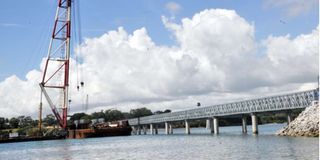Floating bridge will be ready by December 15

Construction of the Likoni floating bridge at Liwatoni jetty in this picture taken on November 26, 2020.
Khamis Ali is sweating profusely. He is in the midst of a huge crowd waiting for the arrival of a ferry at the Likoni channel. It’s a daily routine he has come to hate, as have thousands of other Mombasa residents.
It’s also a hustle that is thankfully coming to an end, thanks to the Sh1.9 billion floating bridge that is under construction. It will be ready for use by December 15. An engineer from the Kenya National Highways Authority (KeNHA), Mr Eric Wambua, said the project was 80 percent complete.
“We have finished the foundation and are now working on the structure above water,” said Mr Wambua in an interview.
During an inspection tour, Coast regional commissioner John Elungata said “we should be able to see people safely and easily crossing from one side of Mombasa to the other.”
Plans for its construction were mooted following concerns over compliance with public health guidelines in ferries.
Speaking to Nation, Mr Elungata said the project, which was developed to ease pressure at the Likoni channel, is also expected to enable tourists, who traditionally throng the coastal city in December, enjoy a smooth crossing.
“This is an iconic bridge and it will be attractive to many. It will also pose as a site for tourism as people would want to come and see and have an experience, therefore we are assuring those coming down to the Coast all is set for the holidays,” he said.
Seamless coordination
Mr Elungata added that there would be seamless coordination of traffic flow at the matatu terminus in Liwatoni. The 715-metre long bridge runs from Liwatoni in Mombasa to Ras Bofu (Peleleza) in Likoni.
The construction works involved establishment of pile foundations and a bailey type bridge (a type of portable, pre-fabricated, truss bridge).
A pile foundation is formed by long, slender, columnar elements typically made from steel or reinforced concrete. A foundation is described as ‘piled’ when its depth is more than three times its breadth .
The upper section comprises lattice steel designed from prefabricated parts with a movable main steel structure. Once complete, the bridge will comprise a 529-metre long floating section and 54-metre long approaches on either side of the floating span, according to design details provided by KeNHA.
It will have a 150-metre movable section mid-ocean, to allow for opening and closing and ease the movement of ships in and out of the port.
According to information from China Road and Bridge Corporation (CRBC) which is the main contractor, the bridge will last seven years before any part of it can be replaced.
End to congestion
CRBC is set to officially hand over the project to the government by the end of the month.
The bridge is expected to help deal with at least 50 percent of pedestrian congestion at the Likoni channel. KeNHA says the crossing bridge, which is one of its kind in the country, will be operational 24 hours.
“We will sit down with the Kenya Ports Authority to see the best way to operate it so that we do not have any areas of conflict,” said Mr Wambua.
The Nation understands that the operations of the floating bridge is among the reasons behind the takeover of the Kenya Ferry Services (KFS) by the Kenya Ports Authority (KPA).
According to plans, the operation of the bridge is to be taken over by KPA, which will deploy its tug boats to open and close the bridge for ships entering or leaving the port.





